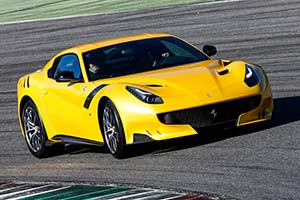
| Ferrari F12tdf |
| Article | Image gallery (60) | Chassis (4) | Specifications |

|
|
<< Prev Page 2 of 2 Extraordinary chassis dynamics, in terms of maximum lateral acceleration and responsiveness, are in part achieved by the increase in the front tyre dimensions, which jump from 255 to 275, along with the front channel size - up from 9.5" to 10". This modification guarantees higher lateral acceleration generated by the front axle but, alone, this would have caused oversteer on the limit, making the car more challenging for less expert drivers. To enable even gentlemen drivers to make full use of the performance, Ferrari developed its new Virtual Short Wheelbase system. Debuting on the F12tdf, the rear axle is active, allowing the rear wheels to pivot around a vertical axis. Using model-based control logic developed entirely in-house by Ferrari, the rear axle steering automatically adjusts the rear wheels, working out the optimal steering angle as a function of the steering wheel angle, speed of steering inputs and vehicle speed. The Virtual Short Wheelbase improves the car's responsiveness to make it feel more agile, with instantaneous turn-in that can be best appreciated on twisty roads and on more technically challenging tracks while, at the same time, improving stability at high speeds. The F12tdf's aerodynamic performance is nothing short of record-breaking - its aerodynamic efficiency figure is 1.6, almost double that of the F12berlinetta. Downforce is 230 kg at 200 km/h, which is an impressive 107 kg more. Development affected every area of the car's surface, producing striking elements that lend its forms a unique sleek power. At the front, a highly complex bumper contributes to downforce generation. It features a radically scooped lower section and incorporates a competition car-inspired splitter, dive planes, floor wings and louvres to boost the efficiency of both the sides and the underbody. The Aerobridge on the car's front flank has been redesigned to increase the energising effect of the air flow along the top of the sides, while at the rear, louvres on the wheelarch create a depression that extracts air from the inner wheelarch, thereby increasing the efficiency of a section of the underbody that is usually little used in generating downforce. The rear spoiler is now 60mm longer and 30mm higher, while the rake of the rear screen has been made more vertical to extend the surface area over which the spoiler can generate downforce and to capitalise on its advantages more effectively. The concave curvature of the rear luggage hatch either side of the rear screen further enhances the solution. Three pairs of GT-racing-derived strakes have been adopted on the aerodynamic underbody and are responsible for 30% of the increase in downforce compared to the F12berlinetta. The rear diffuser has been completely redesigned and now sports a system of three active flaps. It has been split into three channels and features curved fences and vertical splitters to boost the power of the vortexes and enhance the expansion of the flow in the horizontal plane. This radical aerodynamic design work essentially created a whole new car that also marks a major stylistic departure from the F12berlinetta. Designed by the Ferrari Styling Centre, the new F12tdf has particularly imposing yet sensual forms, the product of Ferrari's continuous commitment to melding sculptural beauty with functional demands. All of the bodywork panels, from the chiselled nose to the tail, have been revised. Wider front and rear tracks also give the car an even more aggressive stance. In terms of the formal design language, the objective was to create a sophisticated interaction between the sculptural surfaces of the F12berlinetta and a more graphic treatment of the various new aerodynamic features. The best testament to this intent is the evolution of the Aerobridge, the design of which is further enhanced by the use of bare carbon-fibre. Developed in such a technical manner, this component combines with the other details in creating a coherent aesthetic approach to the whole car. The car's uncompromising sportiness is expressed with the same degree of purity in the deliberately Spartan cockpit. The wrap-around effect that embraces the driving position is intensified by the use of carbon-fibre housings for the instruments and satellite pods. The door panels have been pared back to a single carbon-fibre shell, while the glove compartment has disappeared to be replaced by simple knee padding. Alcantara rather the traditional leather was chosen for the cabin trim, technical fabric for the seats and patterned aluminium instead of mats for the floor, once again with the aim of saving every last ounce of weight. The F12tdf's specification is completed by lightweight alloys with five twinned spokes that are designed to have the narrowest section possible to reduce unsprung weight. << Prev Page 2 of 2 |
| Article | Image gallery (60) | Chassis (4) | Specifications |
| All Cars - Contact us - Privacy Statement - Top | © 1998 - 2024 Ultimatecarpage.com |

